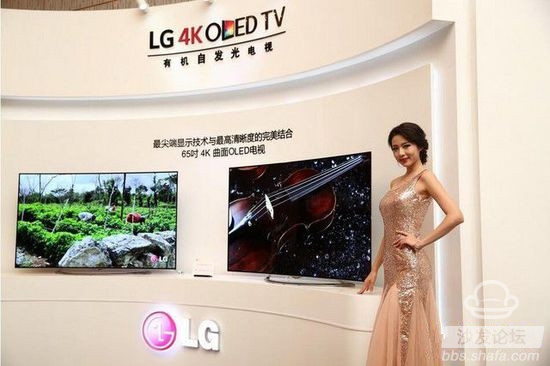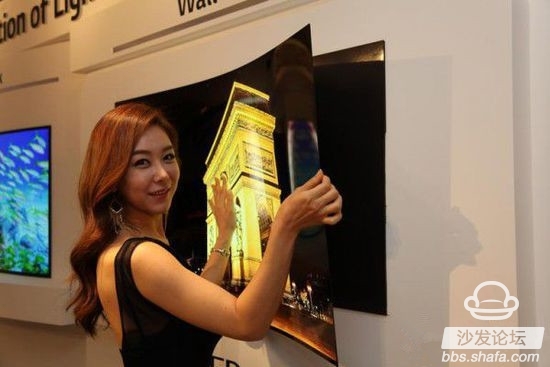OLED stands for Organic Light-Emitting Diode (organic light-emitting diodes). Unlike LCDs, OLEDs feature self-illumination, do not require backlight support, and have high contrast, uniform brightness, and wide color gamut and viewing angle.

LG 4K OLED TV
Secondly, OLEDs have low voltage requirements, fast response, thin thickness, simple structure, high efficiency, and light weight. Unlike the LCD, which is fixed in the glass panel, in theory, as long as a flexible substrate material, such as a flexible material such as a plastic or a metal foil, is used, the appearance of the OLED screen can be changed.

In theory, the appearance of the OLED screen can be changed
Due to the features such as high brightness, high color gamut, and infinite partition, OLEDs have created natural advantages for the display of HDR pictures, and the addition of HDR will also make OLEDs reach a new height in picture quality.
What is HDR then? Why is this technology sought after by so many vendors?
HDR full name High-Dynamic Range (high dynamic range), in fact, is not a new word, in the camera, because the camera's dynamic range (degree of tolerance) is limited, the screen contains both bright and dark contrast scenes, such as the sky and the ground, The camera can only tend to measure the exposure of one of the scenes, with the result that the picture obtained is either overexposed or underexposed.
The camera HDR will quickly take multiple photos with different exposure values ​​and combine them into one. Compared to ordinary images, HDR images can provide more dynamic range and image details. According to LDR (Low-Dynamic Range) images with different exposure times, HDR images are synthesized using the LDR images corresponding to the best detail for each exposure time. . It not only retains the lightness of the brightness but also reveals the darkness of the details. The contrast is high, the brightness is clear, and the color is vivid. This maximizes the look and feel of the photo when it is photographed.

And this time we have to say that television HDR and camera HDR have common places, but they are not the same. Strictly speaking, camera HDR is not really high dynamic range, nor can it really achieve HDR. The HDR dynamic range of the photos has not actually changed, but the additional exposure has brought additional information.
TV HDR is a completely different technology, the difference in the way it changes the picture. The most important aspect of TV HDR is to increase the brightness from 400 nits to 1,000 nits or even higher. The increase in brightness can make the picture more real, especially in outdoor scenes.
While TV HDR dramatically improves the contrast and color accuracy, the bright part of the picture will be clearer, the dark part will be more in depth, and the look will be clearly structured. The increase in color accuracy will make the colors look more pure and bright. As a result, a more pure display effect, a richer warm and cold alternation, and a wider range of colors are achieved. In addition, WCG (Wide Color Gamut) will also come along with HDR, which will greatly expand the color that TV presents, and thus present a more realistic effect. At the same time, TV HDR does not look the same as HDR in photos but only enhances the picture quality.
However, due to the lack of uniform standards, different brands of HDR televisions may have differences in brightness. For example, LG has "ultra-high brightness", Samsung advertised "peak lighting", Panasonic highlights "dynamic range reshaping," Sony offers two solutions, and Sharp chooses Dobly's HDR technology.
Of course, HDR TV needs HDR content to highlight its value. So far, only Amazon's streaming service has some HDR resources. However, Netflix has a very positive attitude toward HDR. Marco Polo launched in 2014 was the first episode to be reset under HDR. In addition, 10 of the 60 home-made dramas launched this year can support HDR. Netflix will recast HDR for some of its streaming media content.

LG 4K OLED TV
Secondly, OLEDs have low voltage requirements, fast response, thin thickness, simple structure, high efficiency, and light weight. Unlike the LCD, which is fixed in the glass panel, in theory, as long as a flexible substrate material, such as a flexible material such as a plastic or a metal foil, is used, the appearance of the OLED screen can be changed.

In theory, the appearance of the OLED screen can be changed
Due to the features such as high brightness, high color gamut, and infinite partition, OLEDs have created natural advantages for the display of HDR pictures, and the addition of HDR will also make OLEDs reach a new height in picture quality.
What is HDR then? Why is this technology sought after by so many vendors?
HDR full name High-Dynamic Range (high dynamic range), in fact, is not a new word, in the camera, because the camera's dynamic range (degree of tolerance) is limited, the screen contains both bright and dark contrast scenes, such as the sky and the ground, The camera can only tend to measure the exposure of one of the scenes, with the result that the picture obtained is either overexposed or underexposed.
The camera HDR will quickly take multiple photos with different exposure values ​​and combine them into one. Compared to ordinary images, HDR images can provide more dynamic range and image details. According to LDR (Low-Dynamic Range) images with different exposure times, HDR images are synthesized using the LDR images corresponding to the best detail for each exposure time. . It not only retains the lightness of the brightness but also reveals the darkness of the details. The contrast is high, the brightness is clear, and the color is vivid. This maximizes the look and feel of the photo when it is photographed.

Before and after using HDR comparison
And this time we have to say that television HDR and camera HDR have common places, but they are not the same. Strictly speaking, camera HDR is not really high dynamic range, nor can it really achieve HDR. The HDR dynamic range of the photos has not actually changed, but the additional exposure has brought additional information.
TV HDR is a completely different technology, the difference in the way it changes the picture. The most important aspect of TV HDR is to increase the brightness from 400 nits to 1,000 nits or even higher. The increase in brightness can make the picture more real, especially in outdoor scenes.
While TV HDR dramatically improves the contrast and color accuracy, the bright part of the picture will be clearer, the dark part will be more in depth, and the look will be clearly structured. The increase in color accuracy will make the colors look more pure and bright. As a result, a more pure display effect, a richer warm and cold alternation, and a wider range of colors are achieved. In addition, WCG (Wide Color Gamut) will also come along with HDR, which will greatly expand the color that TV presents, and thus present a more realistic effect. At the same time, TV HDR does not look the same as HDR in photos but only enhances the picture quality.
However, due to the lack of uniform standards, different brands of HDR televisions may have differences in brightness. For example, LG has "ultra-high brightness", Samsung advertised "peak lighting", Panasonic highlights "dynamic range reshaping," Sony offers two solutions, and Sharp chooses Dobly's HDR technology.
Of course, HDR TV needs HDR content to highlight its value. So far, only Amazon's streaming service has some HDR resources. However, Netflix has a very positive attitude toward HDR. Marco Polo launched in 2014 was the first episode to be reset under HDR. In addition, 10 of the 60 home-made dramas launched this year can support HDR. Netflix will recast HDR for some of its streaming media content.